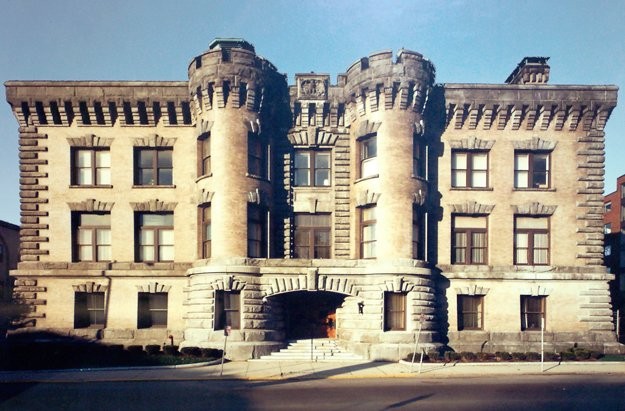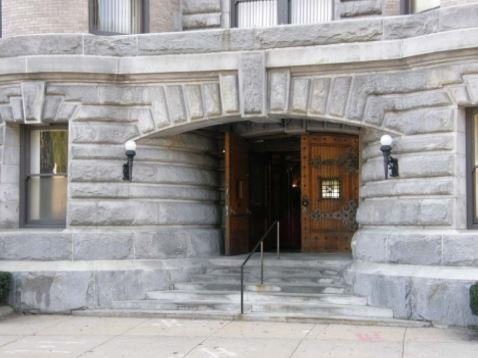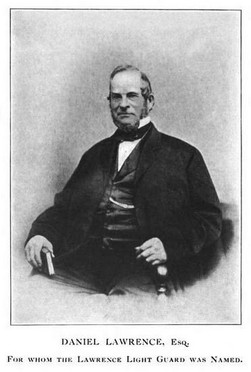Lawrence Light Guard Armory
Introduction
Text-to-speech Audio
Images
Lawrence Light Guard Armory (image from B. Goba & Associates Architects)

Entrance with original oak doors and light fixtures (image from the Massachusetts Historical Commission)

Daniel Lawrence, namesake (image from the Medford Historical Record)

Backstory and Context
Text-to-speech Audio
Originally, the Lawrence Light Guard was located on Main Street in Winchester, Massachusetts. The volunteer militia was formed in 1851, with Boston lawyer (later the mayor of Boston 1877-1888) Frederick O. Prince. Both the town and the company were named after another prominent Bostonian, a merchant named Colonel William P. Winchester. By 1855, citing a “lack of encouragement” from the town, the militia voted to disband; instead, however, a group of Medford men joined the Winchester company and transferred the organization to their own town (2; 3). Company E, 5th Regiment, was subsequently renamed in honor of Daniel Lawrence, prominent distiller of world-renowned Medford Rum (see Clio entry for the Isaac Hall House) (1; 3). Lawrence gave substantial financial support to the company during his lifetime, and his son, Samuel Crocker Lawrence, became its captain in 1856 (2; 3).
Samuel Crocker Lawrence had been in the Massachusetts State Militia as a student at Harvard, and was captain of the Lawrence Light Guard until he was promoted to the rank of Major in 1859 (1; 2). Unfortunately, in 1860, a fire destroyed the Trinitarian Church adjacent to the armory, and the flames spread to the Light Guards’ building. The company had just refurnished its rooms three months later, when a second fire destroyed the armory completely (3). The militia subsequently rented spaces for storage in various buildings on High Street, and met in the Town Hall (2; 3).
At the outbreak of the Civil War, the Lawrence Light Guard was the only Massachusetts militia company to volunteer for service (1). Colonel Lawrence received orders to report to Boston on April 19, 1861, the anniversary of Paul Revere’s 1775 ride, during which he had called the Medford Minute Men to action (3). The 5th Regiment fought with distinction at the First Battle of Bull Run, during which Lawrence was wounded (1; 3). He was afterwards promoted to Colonel, then to Brigadier General of the State Militia (2). A new armory was built in 1862 on the site of the old in Medford, and P. S. Davis took over as colonel of the Light Guard (3). The company went on to serve on picket duty along the Potomac River, as provost guard in Washington, D.C., at the Battle of Mine Run, in the Battle of the Wilderness, and at the Southern Surrender at Appomattox (1; 3). A group of the Light Guard were taken prisoner during the Battle of the Wilderness and taken to Libby Prison, transferred first to Belle Isle, then to Salisbury, where they spent a winter without shelter or cooked food. Many died, and those who came home “dropped out of life,” after returning to Medford in 1863 (3).
General Samuel Crocker Lawrence became Medford’s first mayor
(1893-1894), then worked as a director of the Boston and Maine Railroad. Active
in Medford’s civic life, he was also a trustee of the Medford Public Library,
and financed the construction of a new armory for the Light Guard at the turn
of the century—this is the Lawrence Light Guard Armory of today. The
prestigious Boston architectural firm of Shepley, Rutan & Coolidge, formed
in 1886, was responsible for the design. The building was completed in 1902,
and the Lawrence Light Guard continued to serve throughout the Spanish American
War and both World Wars, as well as joining the American Border Service in 1916
(1; 2). In 1975, the Lawrence Light Guard Armory building was listed on the
National Register of Historic Places. Today, it houses condominiums, but its façade
and entry remain the same (2).
